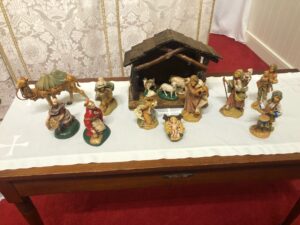Click Here to Download a music file of Jane Webers Christmas Hymns

 A Christmas Eve sermon preached by the Rev. Dr. J. Paul Board at St. Paul’s Episcopal Church, Maumee Ohio, 2020
A Christmas Eve sermon preached by the Rev. Dr. J. Paul Board at St. Paul’s Episcopal Church, Maumee Ohio, 2020
Merry Christmas!
I pray you are healthy and safe at home! This is the strangest Christmas ever, for all of us! Perhaps you have been away from home for Christmas before, but to be home and still feel isolated, well it is just odd.
The Maumee Mirror called me, our own Nancy Gagnet. She was looking for quotes from Maumee Clergy for this Christmas Season. I was happy to comply. She said she had two questions. The first is what is your Christmas message? My message is Hope. Hope is as relevant for us today as it was for Mary and Joseph. Our hope is for a better world, free from the daily anxieties and hardships we encounter.
The second question is what are you hoping for in the coming year? My hope is we remember our lessons learned. Slow down and appreciate our blessings. This is what the pandemic taught me. Slow down and appreciate our blessings. The problem is I didn’t slow down. The pandemic made things busier. I remember being slow in the first few weeks of the shut down. Lori and I took daily walks together with the dogs. Two or more each day. Daisy and Scooter never had so much attention and exercise.
But then life got hectic. They didn’t teach us in seminary how to run a church during a pandemic. Zoom meetings and online streaming wasn’t a thing when I went to seminary. I had to learn the virtual stuff on the fly. I think of myself as a tech nerd, but worship still turned into a huge learning curve. It’s not just getting the internet to work properly. I had to become comfortable preaching into a camera. I failed to follow my own advice. I never slowed down.
How can we be the church, when no one is in church? We had to learn new ways. The food pantry is busier than it ever has been. I am grateful to so many volunteers. I cannot list them all. But I will call out Jane and Deno Music. They haven’t been to worship since the pandemic began, but they are in the food pantry almost every day including Sunday mornings. Currently at this moment the donations of food are so high, the overflow is stacked in the skylight room, with no room for anything else.
My hope for 2021 is we learn the lesson to slow down. It is more healthy for us. Make time for God and each other. Redirect our priorities.
Did you see the Christmas Star this week? Did you look for it? Did you hear about it in the news? Two planets converged in a way they rarely ever do. So close together they look as one in the night sky. Jupiter and Saturn. This hasn’t happened in 800 years. The year was 1226. Some theories say this is what happened over Bethlehem. A conjunction of planets. Other theories say the star over Bethlehem was a comet. It may have been a miracle, or it may have a scientific explanation.
For me, the science behind the Christmas star isn’t important. What matters is the way people thought about it through the centuries. It was a sign the messiah was born. It was a message of hope.
Something else happened 800 years ago, just shortly before the Christmas star appeared in the night sky. A tradition began that shapes our Christmas today. The story begins with St. Francis of Assisi. I must give credit to Alexander John Shaia, an author and speaker who inspired my thoughts on this. For those of us who participated in the Holden Evening Prayer services, you heard the video of Alexander John Shaia talking about St. Francis.
Actually, the Christmas Star appeared the same year St. Francis died, 1226. Two years later Pope Gregory IX made him a saint, the patron saint of Italy.
St. Francis lived a simple life, though there is nothing simple about his legacy. In 1219 Francis traveled to Egypt and then to the Holy Land. He was on a mission to try and end the crusades. He visited Bethlehem and was inspired by the birthplace of Jesus.
At the time most people had come to understand God as a distant God. In theology we use the word transcendent, “beyond or above the range of normal or merely physical human experience.” Transcendent is “out there.” St. Francis might have said Sky God. God was unreachable and therefore un-relatable.
But Francis said no, God is not a sky God. God came to us, here. Right here. God came to us as Jesus, a real human being. But Jesus didn’t just walk over a hill and appear. He was born lowly and in a manger. St. Francis was the first person to create a creche, a nativity, a manger scene, to help us understand the story.
I am guessing you have a creche at home. A manger set. There are Mary and Joseph and the baby Jesus. You may or may not have a shed. There are shepherds and angels, some animals. Our parish set has a little drummer boy and a young flutist. Our atlar guild was laughing; the little drummer boy isn’t in the Bible. Sue Cohen says his last name is Hallmark. We can talk about wether the little flute boy belongs. In the Board home we bring out our manger set with all the other Christmas decorations. The baby Jesus doesn’t come out until Christmas day, or after we have been to church on Christmas Eve.
This is where John Alexander Shaia inspired my thinking. The creche is a model. It isn’t meant to be historically accurate. It points to an historical event, sure, but it represents a Jesus we know and love, who is alive and real in our hearts. Today. Here. Now.
I will quote Shaia: “The manger is a visible expression of the fact that when we find our lives in the deepest dark, just as when nature on this planet is in the deepest dark, that’s where God’s greatest grace comes to our lives.”
This is where hope comes to our lives. When we need God the most, it isn’t a sky God, or a judgement God, or an angry God who approaches us, but a baby Jesus. How can you not have hope when you look on a manger scene.
I don’t know when we can all come back to church. I will be surprised if it is sooner than March. If it is that long, then it will be a year we have been away. Away from church, from our lives that we call normal. Away from friends. So many things are different we can call the pandemic a dark place. This year has been a dark time for all of us. Some of us have lost family and friends to the virus. Some of us had the virus. We all share the fear that we may still catch it and lose something precious.
But a light shines in the darkness. The light does not light the darkness, but shines in the darkness. We see the light and we have hope.
What is my hope for coming year? My hope is we remember our lessons learned. Slow down and appreciate our blessings. God loves us. He gave us his son, whom we call Emmanuel, which means, God is with us.
Merry Christmas!
Paul+

